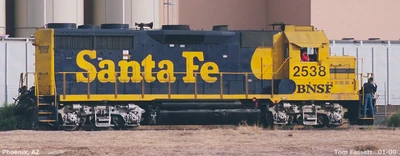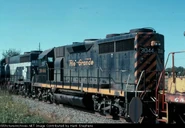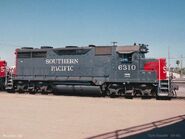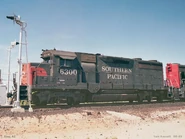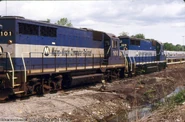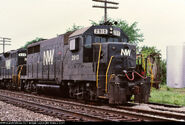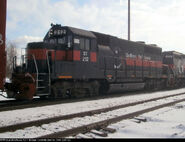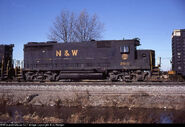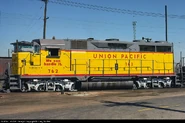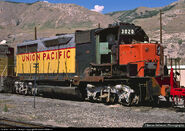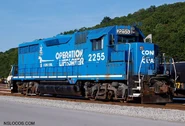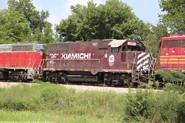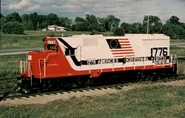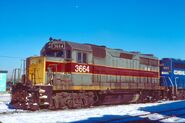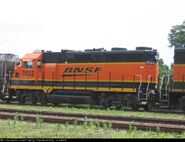Bio[]
The EMD (Electro Motive Division) GP35 is a type of four-axle, 16-cylinder, 2,500hp diesel locomotive built between July 1963 to December 1965 with about 1,135 or so built for a total of 38 customers for the US, Canada, and Mexico.

An Erie Lackawanna (EL) GP35.
The model marked the beginning of a new era for EMD, for it was officially one of the first locomotives produced to compete against long-term rival GE (with their U25B), as well as being one of the first diesels built by the company to have a modern, beveled cab and carbody design found on all second-generation and third-generation models such as the SD40-2 and SD60.
Although the model sold in such a large and rather astonishing number within such a short production timespan, it is often regarded as being "one of the most hated locomotives ever produced in quantity" for many reasons.
Many still exist, though mostly no longer operate in their original condition, for many have since been rebuilt. BNSF is currently the only major Class 1 railroad or system to operate true, non-rebuilt GP35 units. Several are preserved, while others operate on various shortlines (both rebuild and original). Railroads like CP (Canadian Pacific) utilize shells of former GP35 units as non-powered control cab units (similar to the CCRCL units used by UP rebuilt from ex-SP Dash 7's), while CSX uses rebuilt GP35's as road slugs (among other older four-axle "Geeps" like the GP30) to assist local or yard units.
Although common at one time, encountering a true, non-modified or rebuilt GP35 is often a rare sight.
History[]
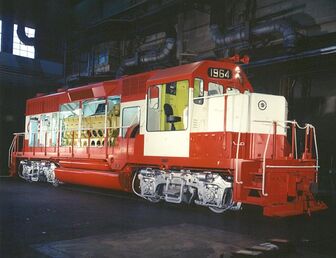
EMD 1964: one of the exhibit GP35 units built for demonstration tours.
The GP35 officially marked the beginning of the second-generation of road diesel locomotives for EMD, for it debuted with many features previously found on the GP30, only with an overall improved design; from the carbody to the interior components, the locomotive model marked the beginning of a new era as one of the first commercially successful turbocharged diesel locomotives built by EMD to sell in greater numbers; far greater than its predecessors. Although the GP30 is arguably considered or regarded as being the first second-generation model to amass close to 1,000 units produced total (948 to be exact), the GP35 is often considered to be the first official model produced by EMD from said generation (yet, often causes debate among railfans and enthusiasts alike, for many even consider 645 models like the SD45 and subsequent SD40 being the first official second-generation EMD diesels).
Making its debut to the public at the 1964 World's Fair in Queens, NY, the GP35 was part of a popular exhibit which paved way towards EMD's increasing success in the locomotive industry. But because of how "power hungry" most railroads were at the time, orders for the GP35 were imminent, for the aging 20-year-old first-generation ALCO and EMD diesels began to show signs of wear and tear, while others unfortunately outlived or didn't live up to their expectations or full potential to completely out-last the steam locomotives in which they previously replaced, or simply didn't meet the high-horsepower demands. Thus, numerous trade-in offers were made and received with railroads. Among the many whom traded-in their tired ALCO and early EMD road units (beside Baldwin, Fairbanks-Morse, among others) were carriers such as the Gulf Mobile & Ohio (GM&O), Southern (SOU), Ann Arbor (AA), St. Louis-San Francisco (SLSF; Frisco), Soo Line (SOO), and Santa Fe's partially-owned subsidiary Toledo, Peoria, & Western (TPW). Said carriers received GP35's riding on distinct ALCO type B road trucks with GE 752 traction motors (or AAR Type B trucks), which some railroads deemed to be far superior than EMD's stock D67 traction motors. Companies like CNW on the otherhand, ordered 20 of their own specialty units with enlarged 3,000 gallon fuel tanks and roof-mounted air reservoirs to accomodate longer distances traveled between stops on the railroad (known commonly as "torpedo tubes"). Said units were reminiscent of the previous "torpedo boat" GP7 and GP9 units ordered previously several years prior.
Meanwhile, western carriers such as the Santa Fe (ATSF), Southern Pacific (SP), Denver And Rio Grande Western (DRGW), Chicago And Northwestern (CNW), Missouri Pacific (MP; Mopac), Chicago Rock Island And Pacific (CRIP; RI), the Wabash (WAB), and the Western Pacific (WP) were among the many western-based customers to order examples of the GP35. ATSF and SP were originally posessed the largest fleets of units prior to the Conrail merger of 1976 in the east, for Conrail acquired a plethora of units from bankrupt railroads such as the Reading (RDG), Erie Lackawanna (EL), and Penn Central (PC). Oddly, some companies such as the Nickel Plate (NKP) ordered only a single unit rather than an entire fleet, for it was the very last new locomotive delivered to the railroad prior to its merger into Norfolk and Western (N&W). Another in particular, was the De Queen And Eastern Railroad of Arkansas, which ordered only a single unit as well (being a shortline).
As the years past, however, the model began to transition over from mainline road service duty and became reassigned to yard or local services with the rest of its "Geep" brethren. As of today, many have since been rebuild into models such as the GP39E, GP39E-2 (or GP39-2E), GP39-3, or GP35R for roads like BNSF, CP, and etc. BNSF is currently the only road to utilize both rebuilt and non-rebuilt GP35 units.
Despite having spent only two years in service, models like the 645-powered 3,000hp GP40 and 3,500hp SD45 stole the spotlight.
Performance Issues[]
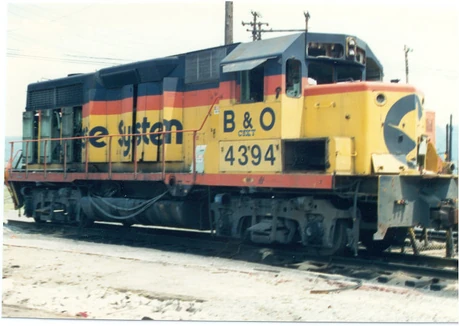
Despite having been successful upon its initial debut, the GP35 was deemed to be rather flawed and problematic; notably with its pure DC electrical system: including the traction motors, wiring, and alternator. Although the limits were pushed with the potential high horsepower output for the turbocharged 567D3 prime-mover, the power assemblies relayed from the alternator to the traction motors caused severe wheelslip issues, furthermore resulting in overloaded axles. Having been one of the last models produced with a straight direct-current electrical transmission (DC alternator routed to a DC traction motor system and so forth), the issues were evident: EMF (back electromotive force) was apparent, which in-turn opposed the voltage output from the main generator and increased as the locomotive accelerated until it matched the generator output and caused the locomotive to stop accelerating. Furthermore, flash-overs were also at risk, meaning that the risk of an overloaded axle would cause a near-simultaneous ignition of the most directly exposed combustible material in an enclosed area. Therefore, the risk of damaging flash-overs limits the maximum voltage the main generator can produce (in other-words, the traction motors were essentially overloaded, and backfired).
Back EMF, however, was further reduced by reducing the magnetic field in the traction motor field coils, though the transition circuitry implemented in EMD F units and early road-switchers included a set of field-shunting resistors that engaged at certain speeds to soak up part of the traction motor field current. Fortunately, earlier models had it easy compared to the GP35, for models like the GP30 had three sets of shunting resistors, while the GP35 had four, which picked up singly in groups as the locomotive accelerated to gradually step down the motor fields and optimize performance.
Apart from said issues, the brakes on the locomotive would often fail when idling; notably in sand houses or locomotive sheds. Often at times crews would have to deal with units slipping out of said facilities, thus infamously being dubbed "bell ringers".
Fearing that they would cause more problems, owners of GP35 units unfortunately demoted them to secondary duties to keep them out of trouble, or were sidelined for storage during traffic slumps.
Enhancements and Modifications[]
Although reliable at first, the otherwise flawed concept of the system became apparent. To solve these issues, railroads simply rewired and replaced every circuit board located behind the cab and retrofitted the alternator and subsequent traction motors for later, more reliable versions or models like the revolutionary D77 motors (which could further tolerate higher voltages) found on models like the SD40-2, which is what the ATSF's Cleburne, TX shops did during 1978 to a plethora of GP35 and GP30 units (dubbing them as "GP35M" and GP30M" or "GP35u" and "GP30u" units). Despite these improvements, their original shunting resistors, however, proved to still be ineffective at times. Later on in the model's lifespan, numerous modifications and improvements were also made to help correct these mistakes. Among these changes include the addition of 645 power assemblies retrofitted to the prime-mover, traction motors, alternator, and vice-versa. And (in some cases), several examples of units were also retrofitted with actual 645 engines; though some were 12-cylinder as opposed to 16-cylinder as a result of the engine displacement (567 cubic inches vs. 645 cubic inches).
Other railroads embarked on GP35 rebuild programs around the same time ATSF initiated theirs. In 1977, Southern Pacific's Sacramento, CA shops followed suit towards rebuilding and/or modifying their subsequent GP35 units, for after rebuilding one prototype, they began contracting companies like Morrison-Knudsen (MK Rail) and Canadian National (CN) to create 60 copies. Sacramento also attempted converting GP35's into exact copies of EMD's highly reliable and more successful GP38 by replacing the turbocharger with a roots-blower and upgrading the prime mover with 645 power assemblies. They converted five units before concluding that the program was deemed to be not economical. Companies like Illinois Central de-rated and de-turbocharged two ex-GMO GP35 units to 1,800hp, while Conrail converted a single ex-PRR unit. They ironically all came to the same conclusion (IC never sought interest in purchasing the GP35, for they preferred the poor-selling 1,800hp GP28). Missouri Pacific's de-turbocharging program, on the other-hand, was more extensive than most, turning out 17 units in the mid-1970's. Three decades later, with the GP38-2 long out of production, independent contractors such as OmniTRAX and National Railway Equipment (NRE) began turning GP35's into what were essentially GP38-2 clones for regionals and shortlines like the Utah Railway, Cedar Rapids & Iowa City, and others.
At least one GP35 went full-circle when it came to turbocharging. One example (DMVW #324, an ex-CNW GP35), was downgraded by having its turbocharger removed from the prime-mover and further converted to being an essential "roots-blown" aspirated unit. Furthermore, the owner of the unit eventually learned the hard way as to why removing the turbocharger from the engine was a rather big mistake, for non-turbocharged EMD locomotives have a tendency to throw sparks from the exhaust. In October 1999 a DMVW (Dakota, Missouri Valley & Western) freight with #324 as the second unit was ultimately blamed for touching off a wind-driven wildfire that over took the train, damaged the 324, and destroyed another GP35 as well as a significant portion of the town of Outlook, MT. After the fire, the unit was rebuilt and the turbocharger was reinstalled.
Burlington Northern (BN) chose to stay with turbochargers in the late 1980's when they contracted with EMD, Morrison-Kudsen, and VMV to build 160 examples of GP39E, GP39M's, and GP39V's from GP30's and GP35's of varied ancestry (similar to SP's "SD40M-2" rebuild program in the 1990's). Most of these 16-cylinder, 2,300hp locomotives lost their middle radiator fans giving them a somewhat "gap-toothed" appearance when viewed from the side. As of today, however, many former ex-ATSF and the remainder of non-rebuilt GP30 and GP35 units have since been rebuilt to GP39-3, GP30u, GP35u, GP39E, and/or GP39-2E (GP39E-2) specifications by BNSF. Very few have evaded or avoided conversion, however, though, are still considered to be "endangered". Many true ex-ATSF GP30 and GP35 units were also leased to Los Angeles Junction (a jointly-owned shortline) years prior to their retirement from 2008-2011. They are now currently awaiting their next fate and are stored at various locomotive contracting facilities such as NRE.
Spotting Features[]
The GP35 is often confused with other EMD models; it can be distinguished by:
- Shorter wheelbase (compared to the GP38 or GP40).
An ex-ATSF GP35 revealing its obvious features in contrast to other "Geep" road diesels.
- Tall, thin exhaust vent or port indicating a turbocharger.
- Smaller radiator fans measuring at 46 to 36 inches (two larger fans accompanied by one distinct small fan).
- Shorter frame (in terms of length and height).
- Many units ride on TradeIn ALCO\GE\AAR#B BogieTrucks instead of standard ElectroMotive#BlombergB\M BogieTrucks. Such examples can be seen on Wheeling And Lake Erie \ WL&E (ex-SOU) HighHood units.
Specifications[]
| Model | GP35 |
|---|---|
| Production Dates | 1963-1965 |
| Total Built | 1,135 |
| Length | 56' 2" |
| Height | 15' 3" |
| Wheel Arrangement | B-B |
| Engine | 16-567D3A |
| Aspiration | Turbocharged |
| Horsepower | 2,500hp (2,135hp or 2,250hp in some cases; some de-rated to just 2,000hp or 1,800hp) |
| Alternator | D22 |
| Traction Motors | D57/D67 (some equipped with GE 752 motors) |
| Weight x 1,000lbs. | 260,000 |
| Maximum Speeds | 71-83 mph |
| Continuous Tractive Effort | 52,000 lbs. |
| Starting Tractive Effort | 65,465 lbs. |
| Continuous min. adhesion | 21% |
| Dynamic Braking Effort | n/a |
| Nominal Weight | 245,000 lbs. |
| Fuel Capacity | 2,600 gallons |
| Oil Capacity | 243 gallons |
| Cooling Water Capacity | 275 gallons |
Gallery[]
Trivia/Facts[]
NKP #910 was the sole GP35 ordered by the railroad built and delivered in 1964. It became N&W 2910 by 1977, and was eventually sold and became Springfield Terminal (part of Guilford Rail) in 1993.
The Metro North Commuter Railroad (MNCR) operates several rebuilt GP35R units for use as road-switchers or as MOW units for Maintenance of Way track services.
The Wheeling and Lake Erie (WLE) is among one of the many shortline railroads currently utilizing a fleet of GP35 units from varied ancestry. Many of which are former Southern (SOU) high-hood units riding on their original trade-in AAR Type B/ALCO trucks with GE 752 traction motors. Some have since had their electrical systems overhauled (notably with 645 power assemblies and/or alternators), and are thus dubbed as "GP35R", "GP35M", or "GP35u".
Sources[]
Trains Magazine Locomotive 2010 (pgs. 58-67)
http://www.american-rails.com/gp35.html
http://www.slideshare.net/davidebender/nkpm-2010-2-atl

